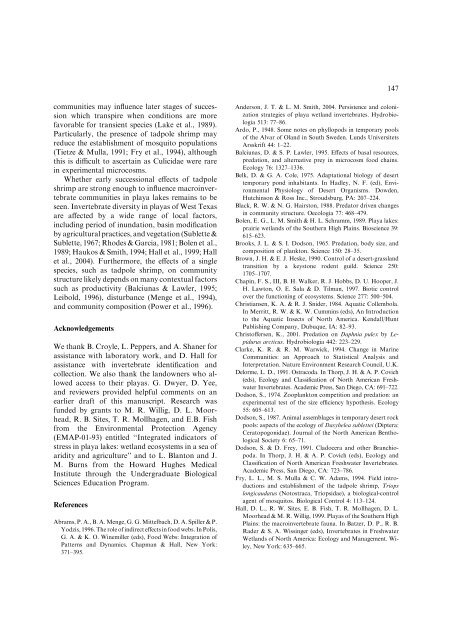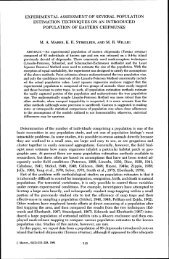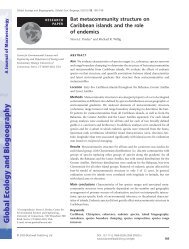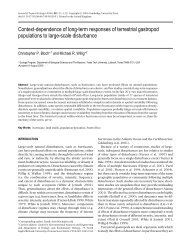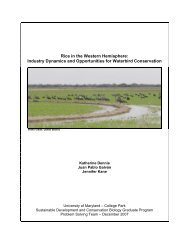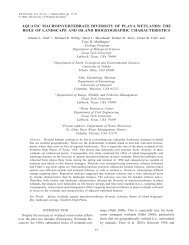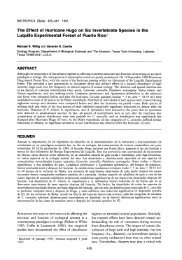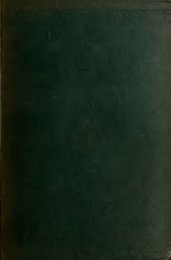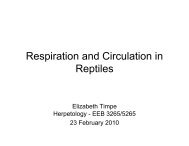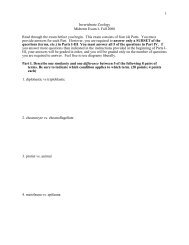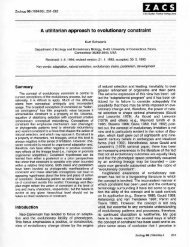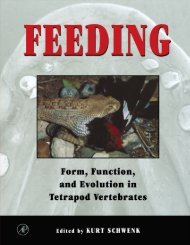Tadpole shrimp structure macroinvertebrate communities in playa ...
Tadpole shrimp structure macroinvertebrate communities in playa ...
Tadpole shrimp structure macroinvertebrate communities in playa ...
You also want an ePaper? Increase the reach of your titles
YUMPU automatically turns print PDFs into web optimized ePapers that Google loves.
<strong>communities</strong> may <strong>in</strong>fluence later stages of succession<br />
which transpire when conditions are more<br />
favorable for transient species (Lake et al., 1989).<br />
Particularly, the presence of tadpole <strong>shrimp</strong> may<br />
reduce the establishment of mosquito populations<br />
(Tietze & Mulla, 1991; Fry et al., 1994), although<br />
this is difficult to ascerta<strong>in</strong> as Culicidae were rare<br />
<strong>in</strong> experimental microcosms.<br />
Whether early successional effects of tadpole<br />
<strong>shrimp</strong> are strong enough to <strong>in</strong>fluence <strong>macro<strong>in</strong>vertebrate</strong><br />
<strong>communities</strong> <strong>in</strong> <strong>playa</strong> lakes rema<strong>in</strong>s to be<br />
seen. Invertebrate diversity <strong>in</strong> <strong>playa</strong>s of West Texas<br />
are affected by a wide range of local factors,<br />
<strong>in</strong>clud<strong>in</strong>g period of <strong>in</strong>undation, bas<strong>in</strong> modification<br />
by agricultural practices, and vegetation (Sublette &<br />
Sublette, 1967; Rhodes & Garcia, 1981; Bolen et al.,<br />
1989; Haukos & Smith, 1994; Hall et al., 1999; Hall<br />
et al., 2004). Furthermore, the effects of a s<strong>in</strong>gle<br />
species, such as tadpole <strong>shrimp</strong>, on community<br />
<strong>structure</strong> likely depends on many contextual factors<br />
such as productivity (Balciunas & Lawler, 1995;<br />
Leibold, 1996), disturbance (Menge et al., 1994),<br />
and community composition (Power et al., 1996).<br />
Acknowledgements<br />
We thank B. Croyle, L. Peppers, and A. Shaner for<br />
assistance with laboratory work, and D. Hall for<br />
assistance with <strong>in</strong>vertebrate identification and<br />
collection. We also thank the landowners who allowed<br />
access to their <strong>playa</strong>s. G. Dwyer, D. Yee,<br />
and reviewers provided helpful comments on an<br />
earlier draft of this manuscript. Research was<br />
funded by grants to M. R. Willig, D. L. Moorhead,<br />
R. B. Sites, T. R. Mollhagen, and E.B. Fish<br />
from the Environmental Protection Agency<br />
(EMAP-01-93) entitled ‘‘Integrated <strong>in</strong>dicators of<br />
stress <strong>in</strong> <strong>playa</strong> lakes: wetland ecosystems <strong>in</strong> a sea of<br />
aridity and agriculture’’ and to L. Blanton and J.<br />
M. Burns from the Howard Hughes Medical<br />
Institute through the Undergraduate Biological<br />
Sciences Education Program.<br />
References<br />
Abrams, P. A., B. A. Menge, G. G. Mittelbach, D. A. Spiller & P.<br />
Yodzis, 1996. The role of <strong>in</strong>direct effects <strong>in</strong> food webs. In Polis,<br />
G. A. & K. O. W<strong>in</strong>emiller (eds), Food Webs: Integration of<br />
Patterns and Dynamics. Chapman & Hall, New York:<br />
371–395.<br />
147<br />
Anderson, J. T. & L. M. Smith, 2004. Persistence and colonization<br />
strategies of <strong>playa</strong> wetland <strong>in</strong>vertebrates. Hydrobiologia<br />
513: 77–86.<br />
Ardo, P., 1948. Some notes on phyllopods <strong>in</strong> temporary pools<br />
of the Alvar of Oland <strong>in</strong> South Sweden. Lunds Universitets<br />
Arsskrift 44: 1–22.<br />
Balciunas, D. & S. P. Lawler, 1995. Effects of basal resources,<br />
predation, and alternative prey <strong>in</strong> microcosm food cha<strong>in</strong>s.<br />
Ecology 76: 1327–1336.<br />
Belk, D. & G. A. Cole, 1975. Adaptational biology of desert<br />
temporary pond <strong>in</strong>habitants. In Hadley, N. F. (ed), Environmental<br />
Physiology of Desert Organisms. Dowden,<br />
Hutch<strong>in</strong>son & Ross Inc., Stroudsburg, PA: 207–224.<br />
Black, R. W. & N. G. Hairston, 1988. Predator driven changes<br />
<strong>in</strong> community <strong>structure</strong>. Oecologia 77: 468–479.<br />
Bolen, E. G., L. M. Smith & H. L. Schramm, 1989. Playa lakes:<br />
prairie wetlands of the Southern High Pla<strong>in</strong>s. Bioscience 39:<br />
615–623.<br />
Brooks, J. L. & S. I. Dodson, 1965. Predation, body size, and<br />
composition of plankton. Science 150: 28–35.<br />
Brown, J. H. & E. J. Heske, 1990. Control of a desert-grassland<br />
transition by a keystone rodent guild. Science 250:<br />
1705–1707.<br />
Chap<strong>in</strong>, F. S., III, B. H. Walker, R. J. Hobbs, D. U. Hooper, J.<br />
H. Lawton, O. E. Sala & D. Tilman, 1997. Biotic control<br />
over the function<strong>in</strong>g of ecosystems. Science 277: 500–504.<br />
Christiansen, K. A. & R. J. Snider, 1984. Aquatic Collembola.<br />
In Merritt, R. W. & K. W. Cumm<strong>in</strong>s (eds), An Introduction<br />
to the Aquatic Insects of North America. Kendall/Hunt<br />
Publish<strong>in</strong>g Company, Dubuque, IA: 82–93.<br />
Christoffersen, K., 2001. Predation on Daphnia pulex by Lepidurus<br />
arcticus. Hydrobiologia 442: 223–229.<br />
Clarke, K. R. & R. M. Warwick, 1994. Change <strong>in</strong> Mar<strong>in</strong>e<br />
Communities: an Approach to Statistical Analysis and<br />
Interpretation. Nature Environment Research Council, U.K.<br />
Delorme, L. D., 1991. Ostracoda. In Thorp, J. H. & A. P. Covich<br />
(eds), Ecology and Classification of North American Freshwater<br />
Invertebrates. Academic Press, San Diego, CA: 691–722.<br />
Dodson, S., 1974. Zooplankton competition and predation: an<br />
experimental test of the size efficiency hypothesis. Ecology<br />
55: 605–613.<br />
Dodson, S., 1987. Animal assemblages <strong>in</strong> temporary desert rock<br />
pools: aspects of the ecology of Dasyhelea sublettei (Diptera:<br />
Ceratopogonidae). Journal of the North American Benthological<br />
Society 6: 65–71.<br />
Dodson, S. & D. Frey, 1991. Cladocera and other Branchiopoda.<br />
In Thorp, J. H. & A. P. Covich (eds), Ecology and<br />
Classification of North American Freshwater Invertebrates.<br />
Academic Press, San Diego, CA: 723–786.<br />
Fry, L. L., M. S. Mulla & C. W. Adams, 1994. Field <strong>in</strong>troductions<br />
and establishment of the tadpole <strong>shrimp</strong>, Triops<br />
longicaudatus (Notostraca, Triopsidae), a biological-control<br />
agent of mosquitos. Biological Control 4: 113–124.<br />
Hall, D. L., R. W. Sites, E. B. Fish, T. R. Mollhagen, D. L.<br />
Moorhead & M. R. Willig, 1999. Playas of the Southern High<br />
Pla<strong>in</strong>s: the <strong>macro<strong>in</strong>vertebrate</strong> fauna. In Batzer, D. P., R. B.<br />
Rader & S. A. Wiss<strong>in</strong>ger (eds), Invertebrates <strong>in</strong> Freshwater<br />
Wetlands of North America: Ecology and Management. Wiley,<br />
New York: 635–665.


